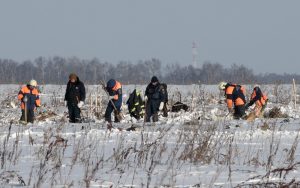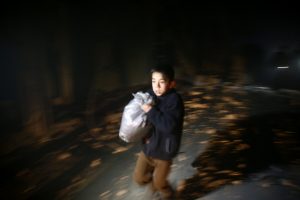
By Laila Bassam and Tom Perry
ALEPPO, Syria/BEIRUT (Reuters) – Syria’s U.S.-backed Kurds are getting indirect help from an unlikely source in their war against Turkey in the northwestern region of Afrin: President Bashar al-Assad.
Pro-government forces and Kurdish-led forces have fought each other elsewhere in Syria and Damascus opposes the Kurds’ demands for autonomy. But in Afrin they have a common enemy and a mutual interest in blocking Turkish advances.
Turkey, which regards the Kurdish YPG militia in Afrin as a threat on its southern border, launched an assault on the region last month. Seeking to shield Afrin, the Kurds asked Damascus to send forces into action to defend the border.
The government shows no sign of doing so, but it is providing indirect help by allowing Kurdish fighters, civilians and politicians to reach Afrin through territory it holds, representatives of both sides told Reuters.
Assad stands to gain while doing little.
The arrival of reinforcements is likely to sustain Kurdish resistance, bog down the Turkish forces and prolong a conflict that is sapping the resources of military powers that rival him for control of Syrian territory.
For the United States, it is yet another complication in Syria’s seven-year-old war, and a reminder of how its Syrian Kurdish ally must at times make deals with Assad even as it builds military ties with the United States.
Lacking international protection, the Kurdish-led forces in northern Syria say they have reached agreements with Damascus to allow reinforcements to be sent to Afrin from other Kurdish-dominated areas — Kobani and the Jazeera region.
“There are different ways to get reinforcements to Afrin but the fundamental route is via regime forces. There are understandings between the two forces … for the sake of delivering reinforcements to Afrin,” Kino Gabriel, spokesman for the Kurdish-dominated Syrian Democratic Forces (SDF), said.
While the Kurds depend on Assad to reach Afrin, Kurdish sources say they also enjoy leverage over Damascus because it needs their cooperation to source grain and oil from areas of the northeast under Kurdish control.
A commander in the military alliance fighting in support of Assad said “the Kurds have no option but coordination with the regime” to defend Afrin.
“The Syrian regime is helping the Kurds with humanitarian support and some logistics, like turning a blind eye and allowing Kurdish support to reach some fronts,” said the commander, who spoke on condition of anonymity.
TURKISH CAMPAIGN MOVES SLOWLY
The Turkish military is making slow gains nearly three weeks into the operation it calls “Olive Branch”.
Ankara views the YPG as an extension of the Kurdistan Workers’ Party (PKK), which has fought a three-decade insurgency in Turkey and is regarded as a terrorist group by the United States and the European Union.
The United States has relied on the YPG as a vital ground component of its war against Islamic State, and has backed the group in other Kurdish-run regions in northern Syria along the border with Turkey.
But U.S. forces are not in Afrin, so have been unable to shield Afrin from the attack by Turkey, its NATO ally.
The Kurds meanwhile accuse Russia of giving a green light for the Turkish attack by withdrawing observers it deployed in Afrin last year.
The Afrin war marks another twist in the complicated story of relations between Assad and the Syrian Kurdish groups, spearheaded by the YPG, that have carved out autonomous regions in northern Syria since the war began in 2011.
The YPG controls nearly all of Syria’s frontier with Turkey. But Afrin is separated from the bigger Kurdish-controlled region further east by a 100 km-wide zone controlled by the Turkish military and its Syrian militia allies.
For much of the war, Damascus and the YPG have avoided confrontation, at times fighting common enemies, including the rebel groups that are now helping Turkey attack Afrin.
But tensions have mounted in recent months, with Damascus threatening to march into parts of eastern and northern Syria captured by the SDF with support from the U.S.-led coalition.
Underlining that, pro-Syrian government forces attacked the SDF in the eastern province of Deir al-Zor, drawing coalition air strikes overnight that killed more than 100 of the attackers, the coalition said.
“The regime has allowed the YPG to bring people into Afrin, while attacking it east of the Euphrates (River). I think that is indicative of the state of relations right now,” said Noah Bonsey, International Crisis Group’s Senior Analyst on Syria.
He added: “There is still a significant gap between the YPG and regime positions on the future of northeastern Syria.”
FIGHTING FOR AFRIN
The main Syrian Kurdish groups remain wedded to their vision of a Syria where they enjoy autonomy in a form of federalism that is at odds with Assad’s determination to recover all Syria.
Each side has allowed the other to maintain footholds in its territory. In Kurdish-held Qamishli, the government still controls the airport. In the Sheikh Maqsoud district of Aleppo, a government city, Kurdish security forces patrol the streets.
Scores of Kurds from Sheikh Maqsoud have gone to Afrin to support the fight, Kurdish officials there said. The short journey requires movement through areas held by the government or its Iran-backed Shi’ite militia allies.
“Of course people went from Sheikh Maqsoud – in the hundreds – to bear arms and defend Afrin,” said Badran Himo, a Kurdish official from Sheikh Maqsoud.
“Around 10 of them were martyred (killed),” he told Reuters as Kurdish security forces held a rally to commemorate one of the dead.
Earlier this week, witnesses say a civilian convoy of hundreds of cars drove to Afrin from other Kurdish-held areas in a show of solidarity.
The Syrian government has ignored appeals by the Kurdish authorities to guard the Syrian border at Afrin.
“We tried to convince them, via the Russians, to at least protect the borders, to take a position, but we did not reach a result,” Aldar Khalil, a top Kurdish politician, told Reuters.
“If they don’t protect the borders, then at least they don’t have the right to block the way for Syrian patriots who are protecting these borders, regardless of other domestic issues.”
(Writing by Tom Perry, Editing by Timothy Heritage)











